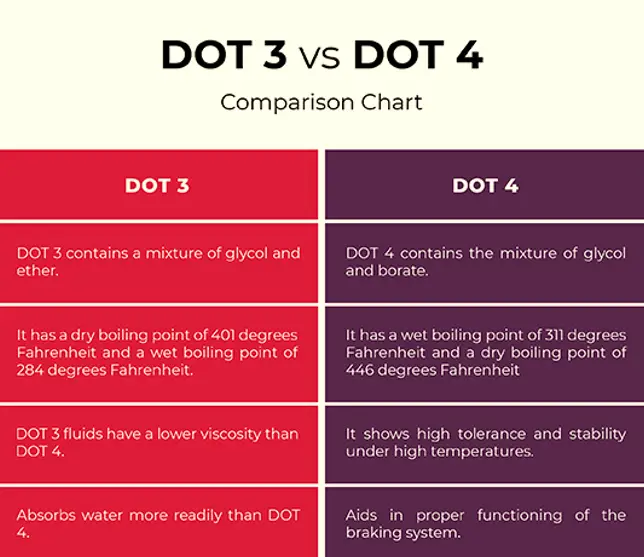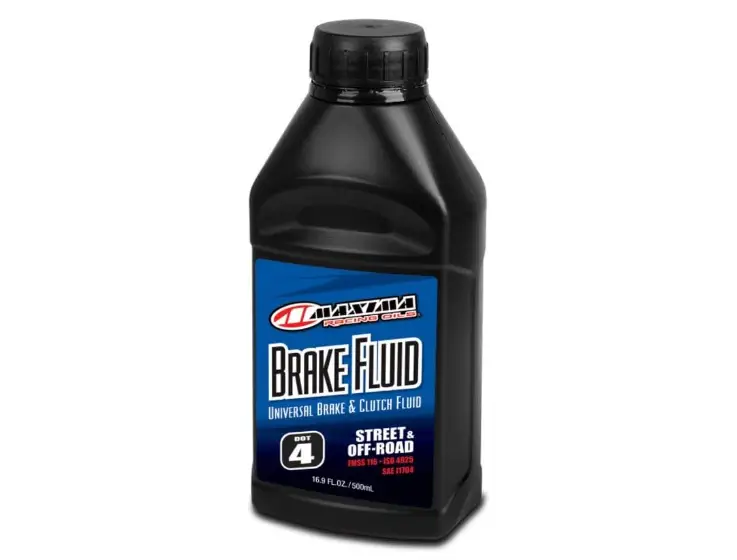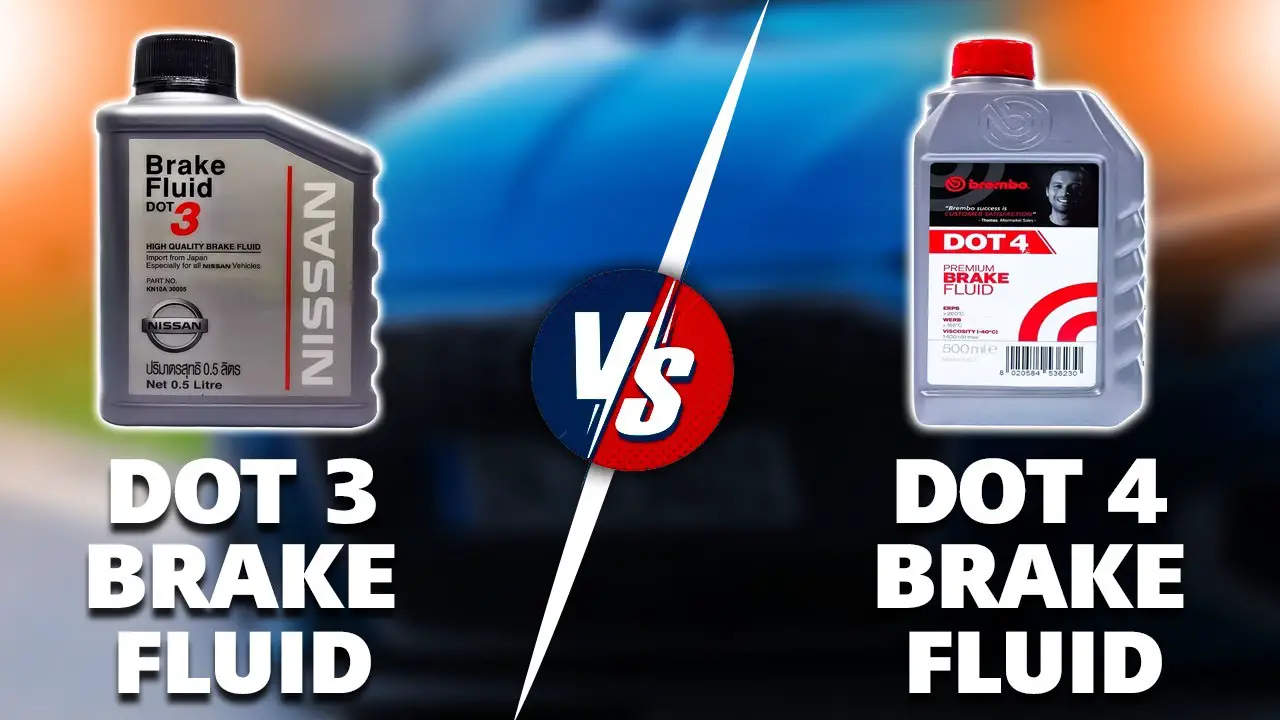Dot 3 brake fluid has a lower boiling point than Dot 4, making it less suitable for high-performance vehicles. Dot 4 brake fluid has a higher boiling point, making it better for heavy-duty or high-performance applications.
Brake fluid is an essential component of the vehicle’s braking system. It transfers the force from the brake pedal to the brake calipers, enabling the car to stop efficiently and safely. Among the various types of brake fluids available, DOT 3 and DOT 4 are the most commonly used. While they may seem similar at first glance, there are critical differences between them that can affect the vehicle’s braking performance and safety.
In this guide, we’ll explore the distinctions between DOT 3 and DOT 4 brake fluids, their benefits, drawbacks, and help you decide which is best for the vehicle.

Credit: www.differencebetween.net
Contents
What is Brake Fluid and Why is It Important?
Brake fluid is a type of hydraulic fluid used in the brake systems of vehicles. It is designed to operate under extreme pressure and temperature conditions to transmit force from the brake pedal to the braking mechanism at the wheels. Its main functions include:
- Force Transmission: Brake fluid converts the pressure applied to the brake pedal into hydraulic pressure, which then activates the brake pads or shoes against the rotor or drum.
- Lubrication: It helps lubricate the brake system components to reduce wear and tear.
- Corrosion Prevention: Brake fluid prevents rust and corrosion within the braking system.
- Temperature Regulation: It maintains its viscosity and effectiveness under a wide range of temperatures, from extremely cold to very hot.
What is DOT Rating?
The Department of Transportation (DOT) classifies brake fluids based on their chemical composition and boiling points. The two most common ratings are DOT 3 and DOT 4. The main differences between these fluids are their boiling points and water absorption characteristics. Both types are glycol-based, making them compatible with each other, but they perform differently under various conditions.
DOT 3 Brake Fluid
DOT 3 brake fluid is a glycol-ether-based fluid that is specifically designed to be used in hydraulic brake systems. It is classified by its performance specifications, such as boiling points and moisture absorption rates. These characteristics are critical in determining the fluid’s effectiveness in transmitting braking pressure and maintaining the vehicle’s safety under different driving conditions.
Boiling Points
Boiling point is a crucial factor for any brake fluid, as it determines how well the fluid can handle heat. When brake fluid boils, it turns into vapor, which can compress. This creates a “spongy” feeling in the brake pedal or leads to brake fade, a dangerous situation where the brakes may fail to work effectively.
DOT 3 brake fluid has two types of boiling points:
- Dry Boiling Point: This refers to the temperature at which the fluid boils when it is new and free from moisture. For DOT 3, the dry boiling point is 205°C (401°F).
- Wet Boiling Point: After absorbing moisture from the air, the fluid’s boiling point drops. DOT 3’s wet boiling point is 140°C (284°F). The wet boiling point is significant because brake fluid naturally absorbs moisture over time, leading to decreased performance if not replaced regularly.

Pros of DOT 3 Brake Fluid
Affordability: DOT 3 brake fluid is generally less expensive than DOT 4 or DOT 5 fluid, making it a cost-effective choice for many car owners.
Widely Available: DOT 3 fluid is readily available at most auto parts stores, making it convenient to purchase and replace.
Compatible with DOT 4: While DOT 3 and DOT 4 fluids have different performance characteristics, they are compatible and can be mixed without damaging the braking system. However, the system will perform at the lower specifications of DOT 3.
Cons of DOT 3 Brake Fluid
Lower Boiling Point: DOT 3 has a lower boiling point compared to other types of brake fluid like DOT 4 and DOT 5, making it less suited for vehicles that experience high heat, such as high-performance cars or vehicles used for towing.
Faster Moisture Absorption: DOT 3 absorbs moisture more rapidly than DOT 4, requiring more frequent fluid changes to maintain performance. If not replaced regularly, it can lead to decreased braking efficiency and potential system damage.
Not Ideal for ABS Systems: DOT 3 may not be suitable for modern vehicles equipped with ABS or ESP systems, which generate more heat and require fluid with higher boiling points.
DOT 4 Brake Fluid
DOT 4 brake fluid is a glycol-ether-based fluid, similar to DOT 3 but with enhanced characteristics to meet the demands of modern braking systems. It is designed to operate under higher temperatures and is more resistant to moisture absorption compared to DOT 3 fluid. This makes it ideal for vehicles that generate more heat in the braking system, such as those with ABS, ESP, or high-performance brake systems.
Boiling Points
Boiling point is a critical specification for brake fluid as it determines how well the fluid can handle the heat generated during braking. As brake fluid heats up, it can start to boil, forming vapor in the brake lines. Vapor is compressible, which leads to brake fade or even total brake failure in extreme cases.
DOT 4 brake fluid has higher boiling points than DOT 3, making it better suited for high-performance or safety-critical applications. It is rated by two types of boiling points:
- Dry Boiling Point: This is the boiling point of the fluid when it is new and free from moisture. DOT 4’s dry boiling point is 230°C (446°F), which is higher than DOT 3.
- Wet Boiling Point: Over time, brake fluid absorbs moisture, which lowers its boiling point. DOT 4’s wet boiling point is 155°C (311°F), which is still higher than the wet boiling point of DOT 3 fluid.

Pros of DOT 4 Brake Fluid
Higher Boiling Point: DOT 4 has a significantly higher boiling point than DOT 3, both in dry and wet conditions. This makes it a better option for vehicles that are driven in extreme conditions or have advanced braking systems.
Better Performance Under Stress: DOT 4 brake fluid is more resistant to vapor lock and brake fade, especially in high-performance or high-speed driving situations.
Improved Moisture Resistance: DOT 4 brake fluid absorbs moisture more slowly than DOT 3, meaning it retains its effectiveness for a longer period before needing to be replaced.
Compatibility with DOT 3: While DOT 4 offers superior performance, it is still compatible with DOT 3 brake fluid, meaning it can be used as a replacement without having to flush the entire system.
Cons of DOT 4 Brake Fluid
Higher Cost: DOT 4 brake fluid is generally more expensive than DOT 3. While the performance benefits justify the price in most cases, the added cost can be a drawback for those who drive older, low-performance vehicles.
More Frequent Maintenance than DOT 5: While DOT 4 offers better performance than DOT 3, it still absorbs moisture over time. This means it needs to be replaced regularly, though not as frequently as DOT 3.
Potential for Freezing in Extreme Cold: Because DOT 4 fluid is thicker than DOT 3, it may become more viscous in extremely cold temperatures, potentially affecting brake performance in winter driving conditions.
DOT 3 vs DOT 4 Brake Fluid: Comparison Table
Here are a comparison table of Dot 3 Vs Dot 4 Brake Fluid –
| Feature | DOT 3 Brake Fluid | DOT 4 Brake Fluid |
|---|---|---|
| Chemical Composition | Glycol-ether based | Glycol-ether with borate esters |
| Dry Boiling Point | 401°F (205°C) | 446°F (230°C) |
| Wet Boiling Point | 284°F (140°C) | 311°F (155°C) |
| Water Absorption Rate | Higher | Lower |
| Best Use | Standard driving conditions | High-performance and heavy-duty |
| Cost | Lower | Higher |
| Compatibility | Compatible with DOT 4 (mixable) | Compatible with DOT 3 (mixable) |
| Maintenance | More frequent replacement needed | Regular replacement, but less frequent |
Which One Should You Choose?
Choosing between DOT 3 and DOT 4 brake fluid depends on the vehicle type, driving conditions, and maintenance preferences. Here’s a breakdown to help you decide:
Use DOT 3 Brake Fluid If:
- You have a standard passenger car or light truck.
- You drive mainly in normal conditions without heavy braking demands.
- You prefer a more cost-effective option with widely available products.
Use DOT 4 Brake Fluid If:
- You drive a high-performance or heavy-duty vehicle.
- Vehicle is equipped with an ABS or electronic stability control (ESC) system.
- You drive in mountainous areas, tow heavy loads, or have a more aggressive driving style.
Frequently Asked Questions
Here are some FAQs about DOT 3 and DOT 4 brake fluids –
1. Can I mix DOT 3 and DOT 4 brake fluids?
Yes, DOT 3 and DOT 4 brake fluids are compatible and can be mixed, as both are glycol-based. However, mixing them will lower the overall boiling point to the level of the DOT 3 fluid, reducing the benefits of the higher-performance DOT 4.
2. How often should I change my brake fluid?
Brake fluid should be changed every 1 to 2 years or according to the vehicle manufacturer’s recommendations. DOT 3 typically requires more frequent changes due to its higher water absorption rate, while DOT 4 can last a bit longer but still needs regular maintenance.
3. What happens if I use the wrong brake fluid?
Using the wrong brake fluid can lead to reduced braking performance, brake system damage, and safety risks. Always use the brake fluid type recommended in the vehicle’s owner manual to ensure optimal performance and safety.
4. Can I upgrade from DOT 3 to DOT 4 brake fluid?
Yes, you can upgrade from DOT 3 to DOT 4 as long as the vehicle’s braking system is compatible. Upgrading can offer better performance under high-temperature conditions. However, ensure that all old DOT 3 fluid is thoroughly flushed out before adding DOT 4.
5. Is DOT 4 brake fluid worth the extra cost?
For vehicles with high-performance requirements, ABS, or ESC systems, DOT 4 brake fluid is worth the extra cost due to its higher boiling points and better performance under demanding conditions. For standard driving, DOT 3 may suffice, and the cost difference may not be justified.
Conclusion
Both DOT 3 and DOT 4 brake fluids have their specific uses and advantages. While DOT 3 is suitable for everyday driving and standard braking systems, DOT 4 offers better performance in high-temperature conditions, making it ideal for performance-oriented and heavy-duty vehicles.
Understanding the differences between these brake fluids and choosing the right one for the vehicle can enhance braking performance and safety. Always refer to the vehicle’s owner manual and follow the manufacturer’s recommendations for the best results.
